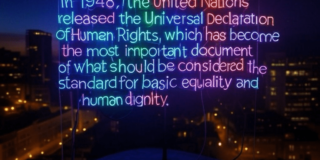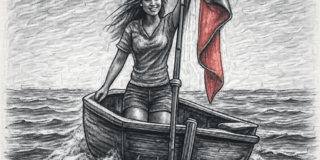There is a battle going on in this country, one the majority would rather ignore. It is a battle for equality between anything to marks a person as not conforming to the mainstream. Like any war, the boundaries keep moving as allies are formed and concessions are made. We are, as a society nominally convinced of the right of each person to equal treatment, but when it comes to the crunch, we allow the inequities of our justice system to continue. Inequities that see a maximum sentence of six years as acceptable for the group assault that ended the life of an apparently healthy indigenous man. Inequities that allow individuals to hide behind a corporation and pay less than $12,000 when they had the responsibility for caring for an Indigenous man on a lengthy drive through the Australian desert, that permits a person to obviate the basic requirement for moral responsibility.
This is a country that has a dual vision of Australians as fair-skinned, sometimes freckled with brown, blond or red hair, or of the black man with black tightly curled hair and gleaming white teeth. These are the two traditional images of Australia’s original settlers and her Aborigines. These are also the images that, if you choose to deviate and look different from the socially accepted norm, derides you and calls you a terrorist.
It is the last one that on this day, Anzac Day, is perhaps the most poignant, for in 1934 Mustafa Ataturk, a Muslim by birth if Agnostic in practice, said to the mothers of Australian and New Zealand servicemen:
“Those heroes that shed their blood and lost their lives … You are now lying in the soil of a friendly country. Therefore rest in peace. There is no difference between the Johnnies and the Mehmets to us. Where they lie side by side now here in this country of ours … You mothers, who sent their sons from faraway countries wipe away the tears. Your sons are now lying in our bosom and are in peace after having lost their lives on this land. They have become our sons as well.”
This is the vision that our servicemen and women fought for and that led to the influx of immigrants in the post war years. It is a vision of inclusiveness and equality, extended across the seas to people that just a few years before were in complete opposition. And it needs to be remembered that fighting alongside Australia’s British descendants throughout each of the wars, were Indigenous servicemen. Which leads me into this, a reprint of my post from last Anzac Day …
Lest we forget. It’s three words every Australian comes to know early in life, recited at Anzac and Remembrance Days, or funerals for the most recently deceased soldier. I honour the men and women who served the Empire, an allegiance with Britain or America as much any person, those of my own family included.
On the Easter long weekend which coincides with Anzac Day, I was prompted to think of the Indigenous Australians who served. Bakchos had his own reflections yesterday, taken to a massacre site by his elders … ironic on this, of all weekends. Appropriate perhaps.
Up to 600 Indigenous Australians have served in all wars since the late 1900s. Approximately 50 men were conscripted and taken to the African continent as trackers in the Boer War. They were from different Aboriginal nations, almost certainly, having been “recruited” from around the country. Blackfellas were not allowed to enlist in battles for the Empire, so there is no record of names – they were simply part of the inventory listed with stock – and no record of re-entry to Australia. The very few who did manage to enlist would have been able to return with their white counterparts. But the limiting factor in the return of the black trackers would have been their colour. The Immigration Restriction Act of 1901, a hallmark of the White Australia Policy, restricted immigration to Australia to those of a fairer complexion. Dr. Dale Kerwin believes that they may have been left, abandoned rather than brought back to their homelands. Were they brought home? The very fact that their names were not even recorded shows the manner in which the army of the time viewed the aborigine …
The men of the Boer War were only the first to go unnoticed. In subsequent battles the Indigenous Australians may have been permitted to enlist and serve alongside their white comrades, but they were ignored when they returned home. They were not entitled to a pension and more land was stripped from their tribal nations for distribution in the Soldier Settlement Scheme, to which they were denied access. With the effective apartheid that held until the late 1960s, a returned black serviceman could not even share a drink with his mates in the pub. To add insult to injury, their children continued to be removed and sent to live with white families or to orphanages. Australia was willing to take and use these men to fill the ranks on the battlefields, but not prepared to acknowledge their worth, to see them as equal to their non-Indigenous counterparts. The only issue in which they found equal treatment was if they died, their bodies being buried where they fell. For an Indigenous Australian, such separation from his country, his Dreaming, must be a terrible prospect.
On this Anzac Day, we remember all the fallen, but in particular at Blak and Black, we remember our Indigenous brothers who fell defending a country that still treats their descendants with disdain.
Follow this link to the Honour roll of the Indigenous servicemen who have paid the ultimate sacrifice for an ungrateful nation.
AT BLAK AND BLACK, WE WILL REMEMBER THEM.



Lest we forget what a waste of young lives WW1 caused all in the name of Pommy imperialism.